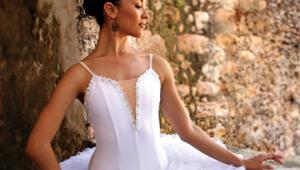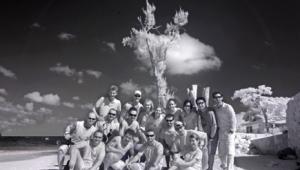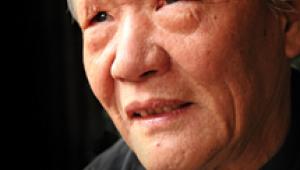Master Class
Point Of View
Add Camera Position To Your List Of Pro Techniques
Have you ever considered creating people portraits? I mean real portraits,
pictures that capture the essence of that individual and have character and
style. If so, I just want you to know that there's a lot more to people
portraits than posing and lighting. One of the most essential ingredients is
your choice of camera position.
That may seem to be "a given," but you would be amazed at how many
people think of camera position as "right about here" or "eye
level" or "shoulder height," and many other similar vague
statements. That's not what we should be thinking when we're creating
portraits. We should be thinking that camera position is an angle of the face.
Camera position should be either full face, 2/3, or profile.
Take a few moments and look at people in commercial advertisements. Look at
the people on TV and in the movies. What the average person overlooks is that
truly great photographers usually pick a camera position that shows one of these
three facial angles. Is it a coincidence? Not on your life! These three camera
positions are as integral to the effectiveness of the image as is the subject's
expression.

Full-Face Portrait
One of my most popular and recognizable images is this full-face portrait. The
lens of the camera was positioned to see the face coming directly toward the
lens. You see the same amount of her ears on both sides of her face. Her eyes
are positioned about 1/3 of the way down from the top of the picture. Her face
is not turned, even slightly, in one direction or another. I'm not showing
you anything new, but what I am trying to stress here is that I was thinking
"full face" when I positioned the camera for this portrait.

2/3 Camera Position
Throughout the history of art portraits have been created with the artist's
eye and/or the photographer's lens at the exact position where you see
the 2/3 position of the face. That is where the viewer sees the front and one
side of the subject's face. You see both eyes with the farthest eye going
almost to the edge of the outline of the face. There is a slight piece of flesh
separating the eye from the background. The tip of the nose does not come close
to the edge of the cheek. The bridge of the nose does not cross over the far
eye. If the nose starts to cover the eye, the face turns more toward the viewer
showing a little more flesh on the outside edge of the eye.
No matter where you look--magazine covers, TV, movies, etc.--more
than any other view of the face you're going to see this 2/3 position.
It's not an accident. It's done purposely, because this is usually
the most flattering angle of the face. It slims a round or angular face. It
shows the cheekbones more clearly than when looking at a full face. From this
angle the facial features are defined more sharply than from any other position.
Look all around you. You'll become more and more aware of the value of
this camera position. See the strength of this man's portrait, created
by placing my lens where it saw that exact angle of his face.

Profile
The profile angle of a face is one that dates back to the caveman. Drawings
can still be seen on walls etched there forever by people who recognized the
character that can be seen by viewing one side of the face. The Egyptians were
also famous for their drawings of profiles, although they drew eyes from the
frontal position. Today, when we photograph people in profile we often have
them looking slightly to the side, so that the camera sees the pupil of the
eye, rather than looking at a blank, white eye socket.
Camera position for the profile is where you see exactly one half of the face.
When photographing a profile I usually suggest that you place your lens in a
position where you see a little of the second eye/eyebrow and then back off
until you lose that. In this way you're sure to see the complete profile.
Oftentimes photographers get too far behind the face and don't show quite
enough of the side of the face, showing more of the back of the head.


















































